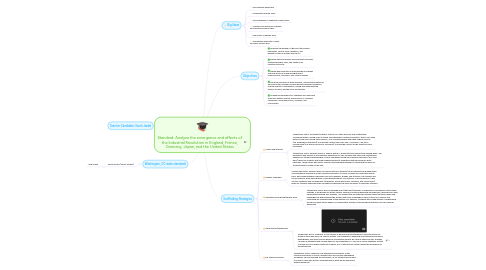
1. Teacher Candidate: Sarah Jaekel
2. Washington, DC state standards
2.1. World History (Social Studies)
2.1.1. 10th Grade
3. Big Ideas
3.1. The Industrial Revolution
3.2. Urbanization around 1800
3.3. The emergence of capitalism around 1800
3.4. Scientific and economic changes and inventions around 1800
3.5. New forms of energy 1800
3.6. The Western evolution of work and labor around 1800
4. Objectives
4.1. Describe the growth of 18th and 19th century population, rural to urban migration, and growth of cities in Europe and the US.
4.2. Explain the connections among natural resources, entrepreneurship, labor, and capital in an industrial economy.
4.3. Explain how scientific and technological changes and new forms of energy brought about massive social, economic, and cultural change.
4.4. Trace the evolution of work and labor, including the demise of the slave trade, problems caused by harsh working conditions, and the effects of immigration, mining and manufacturing, division of labor, and the union movements.
4.5. Analyze the emergence of capitalism as a dominant economic pattern and the responses to it, including utopianism, social democracy, socialism, and communism.
5. Scaffolding Strategies
5.1. Visuals and artifacts
5.1.1. Student key factor: motivation/interest. History can often seem dry and unattainable. Visualizing history, having realia to touch and witnesses to historical events to talk to can make history come alive. During these lessons, I will use photographs and other original sources (e.g. drawings of inventions) to make the content feel more 'real'. If possible, I will try to include realia (e.g. with a field trip to a museum) to make the content of the objective more accessible.
5.1.2. Student key factor: different levels of fluency with ELL students/visual learners/low reading levels. The emergence and effects of the Industrial Revolution is a very complex and often text-lasting topic. Showing my students photographs of labor conditions during the Industrial Revolution (e.g. child labor) helps my students with lower reading abilities to understand the the big ideas I have identified. Using visuals with text is a perfect scaffolding technique for supporting the skills my students have to master in this unit.
5.2. Graphic organizers
5.2.1. Student key factor: different levels of fluency with ELL students/visual learners/low reading levels. The emergence and effects of the Industrial Revolution is a very complex and often text-lasting topic. By providing graphic organizers like Venn diagrams, graphs, and timelines, the students will be more able to grasp the big ideas I have identified above. For example, a mind map about 18th century capitalism and its responses (utopianism, social democracy, socialism, and communism) helps my students understand the concepts and develop the skills necessary to reach the standard.
5.3. Intentional small group/partner work
5.3.1. Student key factor: prior knowledge about the topic/readiness. Collaboration is a powerful instructional strategy, if the groups are wisely chosen. Pairing of grouping high with low achievers, depending on their personalities working well together, can support the low achieving student reach the lesson goals and challenges the high achiever/the student with prior knowledge to take on more of a teacher role, confirming his understanding of the material. For example, a student with a high interest in engineering would be a great group leader in a collaboration activity on technological inventions of the Industrial Revolution.
5.4. Show and tell/thinkalouds
5.4.1. Student key factor: readiness. Social Studies in general and this standard in particular needs my students some key skills, e.g. source analysis. The readiness to analyzing and interpreting cartoons, photographs, and other sources differs a lot between student. By using a "show and tell" strategy, I provide all students with a model they can find orientation in. I will use a "we do together" activity to model a source analysis with my students, e.g. a 19th century cartoon about the emergence of the automobile.
5.5. Pre-teach vocabulary
5.5.1. Student key factor: readiness. The emergence and effects of the Industrial Revolution is a very complex topic and includes challenging vocabulary. By pre-teaching the vocabulary, all my students will be able to come to class with a basic understanding of what we will talk about, without being lost.
